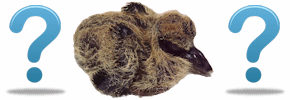We are here to help, but we need your help too.
There are many reasons why a bird may need to come into care. e.g. injury, out of its nest, habitat loss, road victim, orphaned, dog/cat attack, etc.

We are here to help, but we need your help too.
There are many reasons why a bird may need to come into care. e.g. injury, out of its nest, habitat loss, road victim, orphaned, dog/cat attack, etc.

There are five simple steps to rescuing an injured or grounded bird;
Following these steps will give the bird its best chance of being rehabilitated and getting back into the wild.
Please keep in mind that the bird has just gone through, and may still be experiencing, some trauma, such as:
Each step is explained in further detail below. And at any point you can call us or a carer for help ...
VERY IMPORTANT - DO NOT ATTEMPT TO HANDLE A RAPTOR
First, confirm whether or not the bird is a Raptor.
Raptors, also known as 'Birds of Prey', can be very dangerous to handle due to their large claws (called 'talons') which they use to KILL their prey (e.g. small mammals, fish, other birds, etc). If handled incorrectly, while trying to help the injured bird, you could sustain a serious injury.
This guide will help you with Raptor Identification. Perhaps referring to our Photo Gallery may also help you in identifying the species of the injured bird.
If you cannot determine that the bird is not a Raptor, then do NOT attempt to rescue or handle it, but instead immediately contact a carer and follow their instructions.
If you are certain that the bird is one of the many species of common birds that is not a Raptor, and you are comfortable and confident to do so, you may attempt to rescue and handle the bird by continuing to follow these next steps.
There is still a risk of you sustaining an injury from a snapping beak or the thrashing feet when trying to handle a grounded bird. These are natural defensive behaviours, as the bird cannot possibly understand that you are trying to help it and will see you as a threat.
At anytime, if you are not comfortable or not confident about attempting to handle and rescue the bird, then;
The best approach for attempting to pick-up an actively-moving bird, is to first gently throw a small, light towel or t-shirt over the birds head covering its eyes and beak, and preferably its entire body. If the bird cannot see, they will stress less and move less.
The same, or another, towel or t-shirt could also be used to cover the feet when picking up the bird to avoid scratches from the claws.
Calmly, pick up the bird using a both hands to scope from each side of its abdomen, supporting the body and avoiding cradling its feet and legs.
Don't attempt to fold-in any splayed wings, if the bird doesn't fold them in by itself. If you think that attempting to carry or transport the bird with a wing(s) splayed is too difficult or risky for the bird, call one of these trained carers for help...
NOTE: Loud noises can also add to the stress levels of an injured bird. While rescuing an injured bird can be a great education opportunity for children, please ensure that they keep the noise level down (no loud screams of excitement) and also avoid fast, sudden movements.
Simply;
Do not assume because the bird LOOKS ALRIGHT, that it IS ALRIGHT.
An open mouth often can be a visual sign of stress and does not mean that the bird is in need of food.
Attempting to feed a bird can cause additional problems (some can even result in death) so, unless instructed to do so, do not attempt to feed the bird, nor give it water.
Please take note of exactly where the bird was found. This information will need to be shared with any carer or vet that you surrender the bird to, as the bird may need to be released in or around the same location.
Some birds are territorial, which means that if a bird is released into an area that isn't from their own group, they will be attacked and/or chased away by other birds (even by birds of the same species), and as a result will either sustain debilitating injuries or will be killed.
Reach out to a carer or local vet to arrange professional care. Click here for phone numbers and helpful websites.
Thank you. By following the above steps, you have helped to improve the bird's survival chances, and possibly reduced the recovery time for the injured or orphaned bird and its eventual release back into the wild.